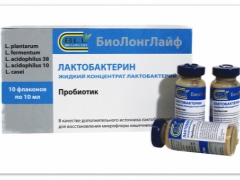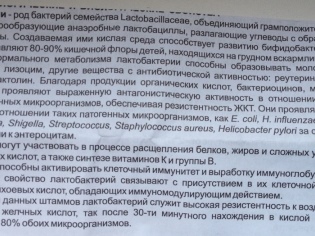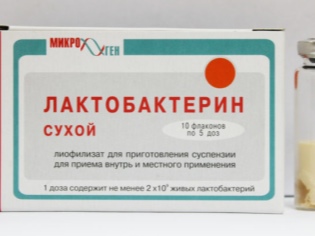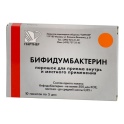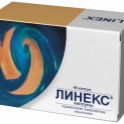Lactobacterin for children: instructions for use
For digestive disorders caused by changes in the composition of bacteria in the intestines, children are assigned probiotics. One of them is Lactobacterin. Why is it prescribed to children and how to give such medicine to babies?
Release form and composition
Lactobacterin is available in the following forms:
- lyophilisate;
- pills;
- vaginal suppositories.
All forms of the drug as an active ingredient contain Lactobacillus acidophilus. Children are often prescribed a lyophilisate from which the suspension is prepared. It is available in vials containing 3 or 5 doses of lactobacilli.
One dose is 2 or 4 billion CFU, and in one box are 10 flakonchikov. In addition to dried live bacteria, the preparation has milk, edible gelatin and sugar. The drug looks like a porous mass or crystals of yellowish, white-gray or beige color.
Operating principle
In lactobacilli, antagonism is observed in relation to opportunistic and harmful microorganisms, for example, to shigella, intestinal sticks and staphylococcus. In addition, the use of Lactobacterin helps to improve metabolic processes and immune protection, and also prevents a prolonged course of intestinal pathologies.
Indications
The drug is applied:
- after acute intestinal infection, if the gastrointestinal tract function is impaired or analyzes show the presence of pathogenic flora;
- with dysbacteriosis, treatment caused by antibiotics, chemotherapy and other factors;
- with atopic dermatitis;
- in chronic colitis, which manifest constipation and other disorders of the gastrointestinal tract.
Also, doctors sometimes prescribe to drip the suspension into the nose (if the child has a long-term rhinitis or adenoiditis), gargle with throat (with tonsillitis) or the mouth (with stomatitis or gingivitis).
From what age is prescribed?
Lactobacterin can be used from birth. This tool is even prescribed to infants, but it is not recommended to give the drug to a newborn, 10-month-old baby or an older child without consulting a doctor.
Contraindications
The drug is not given if the child has hypersensitivity or candidiasis is diagnosed. Due to the presence of sugar and milk in the composition of the drug is also not used for problems with the digestion of sucrose or lactose.
Side effects
No negative reactions usually occur with Lactobacterin treatment. Only in very rare cases, the drug can cause allergies.
Instructions for use
- Dilute the lyophilisate with boiled water, which should be at room temperature. For one dose, take 5 ml of water.
- Pouring the right amount of water Depending on the dosage in the bottle, in a glass, you need to open the bottle of medicine and pour a little water inside to make a homogeneous white-gray or yellow-beige liquid. Then it is poured into a glass and stirred, and then given to drink to the child.
- Divorced medicine should be given immediately to the child. Store dissolved bacteria can not. It is best to drink Lactobacterin before meals, in about 30-60 minutes, drinking medicine with milk.
- A child up to 1 year old is prescribed 3 doses, and a child over one year old - 5 doses. For babies of the first 6 months of life, the medicine is given twice a day, and for babies 6-12 months - three times a day.Lactobacterin should be given twice to a child aged 1-3x, and children over three years old should be given 2-3 times a day.
- The duration of treatment depends on the disease, for example, when dysbacteriosis is advised to take the drug 3-4 weeks, and after dysentery - not less than 4-6 weeks. If after 2 weeks from the start of taking lactobacilli no improvement is noted, it is recommended to investigate the composition of the microflora and select another probiotic.
Overdose and drug interactions
If you exceed the dose of Lactobacterin, no negative effects occur. Since lactobacilli are sufficiently resistant to antibacterial agents, the lyophilisate can be administered simultaneously with antibiotics and any other medications.
Terms of sale and storage
A prescription for the purchase of Lactobacterin at the pharmacy is not required. The average price of 10 flacons at 2 billion CFU of lactic acid bacteria per dose is 150-170 rubles. Vials should be stored in a cool place where the temperature will not exceed +10 degrees. The shelf life for a lyophilisate with a dose of 2 billion lactic bacteria in 1 dose is 1 year, and for a drug with a higher amount of CFU it is 2 years.
Reviews
The treatment of children with Lactobacterin is mostly good. Moms confirm that this tool is effective for violations of the intestinal flora and improves the well-being of the child. The drug is also praised for low cost, ease of use and no side effects.
Analogs
Other drugs with a similar effect on the intestinal microflora can replace Lactobacterin:
- Bifidumbacterin. This medicine in the form of powder, tablets, lyophilisate, capsules or suppositories contains live bifidobacteria. It is used in children of any age, even in infants.
- Linex. Such capsules with lactobacilli, bifidobacteria and enterococci are also prescribed at any age.
- Bifiform This drug in the form of powder, tablets, solution and capsules, contains enterococci, streptococci, bifidobacteria and lactobacilli. He is also discharged to children of any age.
- Hilak forte. Such drops contain metabolic products of beneficial bacteria and can be prescribed for dysbacteriosis from birth.
- Baktisubtil. Such capsules contain bacteria Bacillus cereus, prescribed to children over 7 years old with rotovirus, salmonellosis and other diseases.
- Atsipol. This probiotic in capsules contains not only lactobacilli, but also polysaccharides, which are obtained from kefir fungus. Medication prescribed from 3 months.
You should not choose an analog yourself.
For any discomforts in children, it is important to contact a pediatrician - a specialist will help determine which probiotic is best suited for a small patient.
You will learn more about using lactobacilli for children in the following video.
